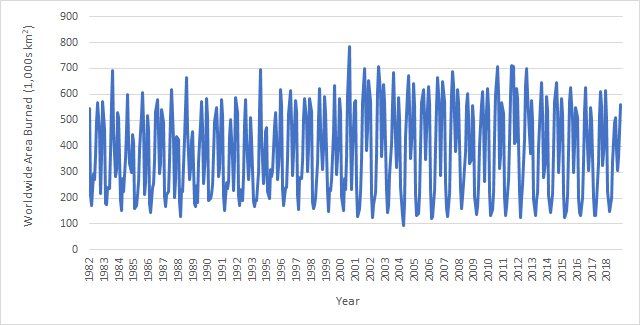
One of the more common myths associated with “climate change” (aka global warming) is the idea that wildfires are on the rise. Consider, for example, the article entitled, “How do we know wildfires are made worse by climate change?” It states:
In 2019 Australia was burning. In 2020 Siberia and California were burning. These are only the more recent examples of dramatic extreme wildfire. People are asking if forest fires are linked to climate change.
The experts tell us that yes, the growing extent and increasing severity of wildfires are indeed driven by climate change.
There is only one problem with such nonsense: wildfires are most definitely NOT increasing in severity. How do we know this? The European Space Agency has been using satellites to track global wildfires. At first, their data sets started in the year 2000, and those data sets show that over the past 20 years, there has been a slight decrease in the amount of land that was burned by wildfires.
However, they recently used historical satellite images to increase the length of time covered by their datasets. We can now trace the amount of land burned by wildfires all the way back to 1982. Thus, we have nearly 40 years worth of data that cover the entire world. What do the data show? The graph is at the top of the article. As you can see, there is no discernible trend. The amount of land burned by wildfires changes from year to year, but the average remains remarkably constant.
Like much of what you read about “climate change,” then, the idea that wildfires are becoming more severe or more frequent is just patently false. Unfortunately, no amount of data will stop this false claim from being promulgated, because most people writing about this issue care more about their agenda than they do about science.

The article you quoted said “The experts tell us that yes, the growing extent and increasing severity of wildfires are indeed driven by climate change.” That made me very curious, so I followed the link to the original article to find out who those “experts” are.
Here’s what they say:
“On the facts of climate change there is one preeminent forum where experts establish consensus. It’s called the Intergovernmental Panel on Climate change, also known as the IPCC. The process they use to achieve consensus is extraordinary and the results achieved irrefutable.”
That reminds me of the saying “to a man with a hammer, every problem looks like a nail.” Of course the Intergovernmental Panel on Climate Change is going to attribute wildfires to climate change. That’s their job. They’re not experts on satellite data nor on wildfires, but on attributing bad things to climate change.
It particularly bothers me that the article says the IPCC consensus is irrefutable. Only God deserves that level of trust and adoration. With human beings we should exercise discretion and critical thinking.
Well, to some people (probably including the author of that piece), the scientific consensus IS God.
Well said, sir!
Living in south central Arizona, we see a lot of fires in the state. Almost all are on or start on federal-controlled lands. These fires result from too much fire load, dead brush and weeds, ect. People are no longer allowed to gather firewood as families have for centuries, and livestock are restricted. Large animals like cattle and horses will knock down and trample dead plant material, even small trees, to the ground where our native, nomadic termites can access it, and break it down, then bury it. The Bighorn Fire on the Catalina Mountains (part of a national forest) stopped only when it reached pastures. Walk in His beauty
If fires increase that should lead to reduced fuel load in the following few years, and hence less fires. Since there is a feedback mechanism perhaps we shouldn’t be surprised that is not easily discernible even if climate change is having an affect.
However the point of your article is still valid. The data does not support the claims made.
In Australia the aborigines used fire management and I read somewhere they said the land should be burned every 3 years.